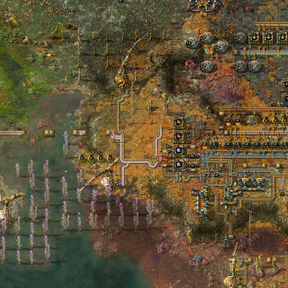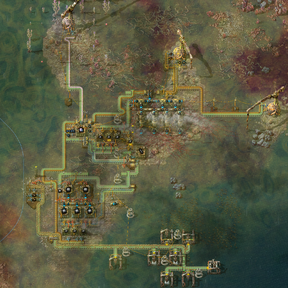Also known as: Gleba for people who don't like Gleba.
Dredgeworks and Cargo Ships are recommended as part of the intended experience.
Does not alter the vanilla products of Gleba directly, but substantially recontextualizes them through the world layout and new early alternatives. If you're daunted by Gleba imposing spoilage and pentapod threats at the same time, this mod should ease you into the production processes a lot more.
Compatible with Any Planet Start's Gleba start, and appears compatible with Only Gleba as of 0.6.1, though selecting a favorable seed is highly recommended; gallery screenshots are from the APS test game.
Factorissimo is a great pairing as well, especially on higher water coverage where space is particularly tight, and the Ironclad is majorly beneficial for fighting your way into new regions before you have access to more sophisticated weaponry.
Fish Traps is a neat way to get local fish if you're using another mod that very much wants them sooner rather than later.
Balance of new plants and adjusted worldgen is still open to adjustment; thoughts welcome.
If you have an existing world from 0.7.2 or earlier, or a vanilla world, please see the footnote.
World Generation
The influence of Gleba water coverage on terrain elevation is substantially retooled, with the coverage scalar altering land distribution of the world you receive. This has a heavy bearing on how things will play; default coverage has been tuned substantially since initial release and is now the recommended setting if you're not sure what to pick, but you should try higher or lower settings in map generation view to see how they affect things.
-
All water coverage scales are guaranteed to have a chunk of highlands in your starting area as a base of operations; it'll vary somewhat in size and contiguity, but serves as a reliable construction area to utilize until you have refined concrete production online.
-
At default (100%) water coverage, you'll receive a "balanced" archipelago sizing - it typically has a good amount of wetland you can reach on foot, and is unlikely to have pentapod nests which will put immediate pressure on you. A special component in the starting area generation will attempt to give you an isolated island providing safety against expansion; if you'd like to ensure you have a cozy experience, check your seed to make sure you have a contiguous "moat" around the starting area and a few solid patches of fertile soil.
-
Increased water coverage will gradually submerge the non-starting islands, whittling land into shallows and shallows into ocean. This can make it easier to defend against pentapods due to constricting or entirely severing island chain connections. To compensate for the loss of total land area, fertile wetlands and soils become more frequent as water coverage increases (can be disabled), with the most extreme coverage leaving you with virtually nothing but ocean and lush planting areas.
-
Lower water coverage will instead raise more land, retaining large bodies of water but gradually connecting landmasses and raising typical altitude, introducing more highlands in the process. Going all the way to 17% coverage will merge almost all landmasses and introduce vanilla-sized highlands, with only a few remaining islands, and pentapod expansion will occur essentially unimpeded.



With Dredgeworks installed, stone can now generate underwater along island coastlines, requiring seafloor drills for extraction. These stone deposits are not quite as rich compared to those you'd find back on Nauvis (though they do grow richer with distance from the starting area), and can't benefit from the yield bonus of big mining drills, but nevertheless serve as a useful source of the material; you'll likely want to have a way to bring stone harvests into a central hub and keep relatively little infrastructure at the mining site itself.
Some further changes provided by Dredgeworks are the ability to directly place refined concrete as a landfill alternative (it's much more resource-efficient, and setting up production for it should be a high priority in advance of base expansion) and the option to create floating belts and inserters (the former of which is quite useful for cultivation in the shallows).
Cultivation
Three Gleban species - cuttlepop, sunnycomb and water cane - have been adjusted to be part of simple production cycles for core resources, which grow in a much wider variety of areas. You will still want to grow yumako and jellynut once you are able to, for the much higher yield and greater product variety they provide (even for metals alone, they yield 13 times the fruit per minute, and each fruit is roughly double the bacteria).

-
Sunnycomb is grown in any soil (non-paved) on Gleba, including landfill, and yields sunnycomb propagules which can be directly replanted or broken down into three spoilage and two copper bacteria. Harvests occur every eight minutes, producing seven sunnycomb propagules (net yield of six).
-
Cuttlepop is grown in any Gleban shallows, and yields cuttlepop pods which can be directly replanted or broken down into four spoilage and two iron bacteria. Harvests occur every four minutes, producing four cuttlepop pods (net yield of three). It's a bit higher in spoilage yield than sunnycomb due to more imposition from its planting conditions.
-
Water cane is grown in any Gleban shallows, producing three pieces of cut water cane every two minutes and fifteen seconds (net yield of two). Cut water cane has an identical fuel value to wood, and can be put through water cane separation to turn two pieces into one wood (improvable with a biochamber) if you need wood for crafting.
The agricultural tower can perform all of these planting activities; it will not provide special highlighting for valid planting territory (as that functionality is reserved for the high-yield crops yumako and jellynut and distinct highlighting is unfortunately not possible), but the basic crops can go in any shallows or soil as appropriate, so you have a much broader selection for tower locations and they're quite useful for supplying isolated operations.
All of these crops are combustible, with water cane being the most effective per area for this purpose, allowing straightforward production of burner power.
As a supplementary alteration, the assembling machine 1 has also been permitted to craft organic-or-hand-crafting recipes, such as sunnycomb and cuttlepop processing, to ensure you can start automating the basic crops' output handling promptly.
Technologies
Resin Processing
Extracting copper bacteria from local flora clues you into a secondary component of sunnycomb that, when processed under appropriate conditions, should make a particularly viable combustible. Volatile resin is produced in a chemical plant from one wood, one sunnycomb propagule, 500 water and 100 steam, producing 250 volatile resin per batch. It's pretty versatile stuff for your explosive needs.
-
The simplest use is direct: Volatile resin fed to flamethrower turrets is particularly effective due to its stickiness, with 20% more damage versus crude oil. It does, however, have to be direct; that same stickiness makes it less than practical to package for portable use.
-
Assemblers that accept fluid inputs can produce grenades from volatile resin, requiring 5 iron plates and 500 volatile resin. This provides a straightforward way to reach military science on Gleba starts (Any Planet Start is adjusted to respect this change).
-
Higher-yield explosives can also be created from volatile resin, but are a bit more complex; they can be produced in a chemical plant or biochamber, and consume one sulfur, two carbon and 200 volatile resin to produce two explosives.
-
With some supplementary research, it's possible to build rockets that directly combust resin for a much simpler production process, simply requiring three iron plates and 150 volatile resin in an assembler that accepts fluid inputs; this makes it possible to set up local manufacture of rockets at chokepoints (particularly with research - more on this later), simplifying the logistics of keeping them supplied with defenses.
Water Level Manipulation
In addition to expanding sunnycomb planting space with landfill and construction space with refined concrete, you can put down new "lakebed mulch" to expand your shallows, created from ten stone, ten wood and five nutrients. It's less expensive than landfill and can benefit from biochamber productivity in the long run, and in addition to its main use for more basic planting space, is useful for connecting a rudimentary footpath.

You're not limited to adding height, either. The excavation brace can be researched after lakebed mulch and concrete; manufactured with refined concrete and iron sticks, it pins Gleba's bouncy "skin" down to lower the water level, turning any eligible terrain (less-fertile "soil" in Gleba's lowlands) into shallows ready for cultivation.
As an alternate behavior (which may be enabled by config), the excavation brace can instead allow you to turn Gleba shallows into deep water, if you would like to create full moats against pentapod attacks.
Fungal Productivity
As you gain a better understanding of the structure of the plants you're cultivating, it becomes clearer what's useful and what's not. Fungal productivity improves the productivity of sunnycomb and cuttlepop processing by up to 50% - while this won't (and shouldn't) make them competitive with yumako and jellynut in raw output, it provides a nice boost (particularly in Gleba starts) and the lower tiers of the technology are inexpensive.
Additionally, volatile resin and resin-based rockets receive a boost from this productivity research; with high tiers, it becomes much more practical to set up local rocket production wherever rockets are needed to keep a chokepoint safe.
Gleba Start Quality of Life
From 0.7.2 onward, On Wayward Seas makes a few supplementary changes to make Gleba starts more approachable, activated based on the condition of Any Planet Start set to Gleba or Planet Picker being present at all. These can be disabled in settings.
-
The evolution curve of stompers and strafers has been adjusted. They do not begin appearing at all until 10% evolution, will not start upgrading to medium until 30% evolution, and will not start upgrading to large until 70% evolution. Wriggler evolution curve is unaffected. This does not apply if starting elsewhere by default, but can be made to do so in settings, with the evolution delay options.
-
Carbon fiber and the rocket turret have had their science pack costs reduced; the number of packs have decreased by 60% and 75% respectively, and space science is no longer among the required packs.
World Generation Revisions
On Wayward Seas' world generation has been adjusted previously and may change again, and if an update significantly changes generation procedure, the intent is to maintain support for old generation revisions. If you started a world with an earlier version of the mod, the list below lets you match settings to that version's worldgen. Current list of generation combinations:
-
Revision 1, no fertility adjustment: Initial release - 0.3.0
-
Revision 2, no fertility adjustment: 0.4.0 - 0.5.6
-
Revision 2, including fertility adjustment: 0.6.0 - 0.7.2
-
Revision 3, including fertility adjustment: 0.8.0+
Fertility adjustment does not have a substantial effect on worlds at default scale.
It's also possible to turn off Wayward Seas worldgen entirely; this will not give you the intended experience, but allows trying out the new crops in a previously-vanilla save.
Localizations
Localization is now being accepted by pull request. Anyone who submits an accepted localization will be listed below, as both credits and a contact reference if translations are missing or inaccurate.
Fr-Dae has provided French and Russian translations.



